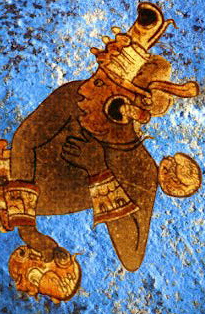A dog’s life long ago
BY GEORGE PAWLACZYK
News-Democrat
BROOKLYN – In ancient Illinois, small dogs were made to carry or pull
sacks of firewood until the tips of their vertebrae broke.
Sometimes their heads were lopped off with stone axes during sacrificial
ceremonies. Most often, they were buried with the trash.
No wonder canines kept by Indians in the Midwest were described in early
European explorers’ journals as nasty tempered and prone to bite. They
were also believed to be unable to bark but still served as watch dogs,
perhaps by nibbling on a sleeping Indian’s toes.
Nevertheless, an evolving archaeological record in the metro-east shows
that these small 25- to 35-pound primitive animals became as ingrained
in ancient human existence as today’s pampered canine pets.
In Southern Illinois a thousand years ago, it was truly a dog’s life,
according to 60 complete or partial dog skeletons recovered from the
remarkably well-preserved, buried remains of a village from an era
archaeologists refer to as “Terminal Woodland.” The site is just outside
Brooklyn and is well clear of a nearby modern cemetery.
This fishing village was primarily occupied until about 950 A.D., or
just before the explosion of mound building that marked the more well-
known Mississippian Culture, whose members built the raised earthen
complex at the Cahokia Mounds Interpretive Center a few miles away.
The skeleton total from the Brooklyn site, first excavated in 2003, is
probably a North American record for the recovery of prehistoric dog
remains, said Joe Galloy, a Harvard-trained archaeologist. Galloy’s
specialties include interpreting the relationship between dogs and the
earliest Americans.
“If there is something that really pulls on the muscles, this bone, the
spinous process will fracture and reheal, and this is an example of
one,” said Galloy, holding up a delicate, deformed vertebra on which the
shark-fin like bone tip that anchors back muscles was bent.
“You see this in modern sled dogs,” he said, “This comes from being used
as pack animals, probably hauling firewood.”
On a large sheet of white paper spread on a table in front of Galloy at
the offices of the Illinois Transportation Archaeological Research
Program in Belleville, was the nearly complete skeleton of a young,
female dog recovered from the excavation site.
Galloy said this creature is descended from wolves that probably prowled
human camps and dumps 15,000 or so years ago in Europe and Asia and
gradually changed in appearance to resemble today’s dogs. Galloy said
the wolves, in return for scavenging, became the eyes and ears of the
humans and eventually became their hunting partners.
At another archeological site — the Koster Site along the Illinois
River in Calhoun County — one of the earliest North American dog
burials was uncovered in the 1970s. Radiocarbon dating showed it is
about 8,500 years old.
This animal, however, was probably a revered hunting dog and was
interred separate from a trash pit and had been reverently laid on its
side, just like rare human burials from this much earlier time.
But the dogs found by excavating teams at the Brooklyn dig headed by
Galloy and site supervisor Brad Koldehoff were not hunting partners. By
the time of this particular village, fishing and growing corn had
replaced nomadic hunting.
The Brooklyn site, which has gained a national reputation, is officially
known as “Janey B. Goode.” The nickname derives from the old Chuck Berry
song and is a tribute to the location’s archaeological riches.
“In contrast to earlier times, when the men went out hunting and the
dogs went with them and were very highly valued, at this time people
settled in one spot and the dogs became women’s’ helpers,” he said.
Another use, albeit a grisly one, was as sacrifices, probably to dispel
sickness in humans.
Six of the dogs, all males, were found buried and headless. Two dogs
were found with their heads still intact, but with their skeletons bound
back to back with the skulls facing east and west.
Dog remains found from a time a few hundred years later at Cahokia
Mounds were burned and had cut marks indicating the creatures had been
used as food, said Koldehoff, the excavation director. Koldehoff pointed
out that within a span of maybe 500 to 600 years, early dogs went from
hunting partners, to pack animals to dinner fare.
But weren’t there some ancient people, children perhaps, who cuddled
primitive puppies and maybe even played with them?
Koldehoff said he thinks that had to have happened, but there is no
physical proof.
“There’s certain things you can’t dig up,” he said. “You can’t dig up a
dance. You can’t dig up a song. And you can’t dig up somebody petting a
dog.”
Contact reporter George Pawlaczyk at gpawlaczyk@bnd.com and 239-2625.
© 2006 Belleville News-Democrat and wire service sources. All Rights
Reserved.
http://www.belleville.com


